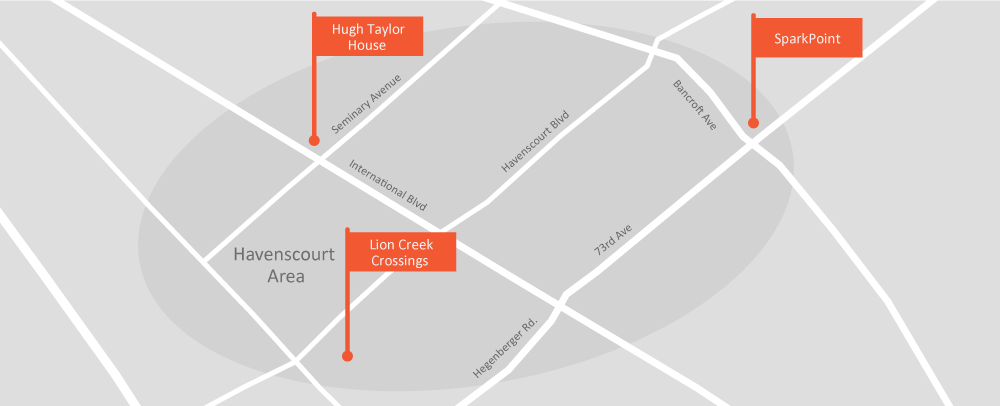About
Informed by the community’s priorities, The Healthy Havenscourt Collaborative seeks to improve factors such as education, workforce development, housing, local business development, community leadership, and stress that will lead to better long-term health outcomes for residents. We also recognize how much environmental, economic, social, and healthcare access affect chronic conditions such as asthma. The Collaborative will build on neighborhood assets, align efforts, and pool resources to better achieve common outcomes. Questions about Havenscourt? Please contact Aurora Chavez at achavez@ebaldc.org.
History
The Havenscourt neighborhood in East Oakland, once a middle-class streetcar suburb, was a thriving community for many people of color who migrated to Oakland in the early part of the 20th century. Today, we see the results of changing economies and major infrastructure projects that have fueled decades of disinvestment and transformed Havenscourt into an area known for violence and scarce resources. While the neighborhood still boasts many schools, a diverse community, and access to transportation, it has been stigmatized as one of the region’s most impoverished and unhealthy

Neighborhood Statistics
- Havenscourt is a very diverse neighborhood, with 95% people of color (primarily African American and Latino)
- Chronic absenteeism, as high as 27% in some schools, keeps kids from succeeding
- 68% of people live 2x below the federal poverty level, compared to 4% in Oakland hills neighborhoods
- Over 60% of Havenscourt residents spend more than 30% of their income on housing
- Havenscourt is a relatively young population; 57% of the residents are under 35 years old
- In 2015, about 25% of residents in Havenscourt lived on less than $15,000 in household income and benefits
- In 2015, approximately 16% of Havenscourt residents were unemployed compared to 10% in the City of Oakland as a whole.
- Havenscourt has some of the highest hospital admissions and ER visits for asthma in all of Oakland; African Americans are almost twice as likely to visit the ER than residents of Havenscourt as a whole
- One of the strongest predictors of kindergarten readiness is preschool experience, and approximately a third of incoming Havenscourt kindergarteners do not have any preschool experience.
Sources: ESRI, American Community Survey, OSHPD via Alameda County Public Health Department, Oakland Unified School District Preschool Experience Study
Healthy Children
Education: Improve kindergarten attendance and parent engagement
Work with schools, community partners, and parents to ensure children are kindergarten-ready and attending school regularly.
Education: Increase youth entering the workforce or attending college
Ensure at least 90% of youth we work with, 10th grade and up, are involved in career pathway activities, such as job shadowing or internships
Healthy Families
Social Services: Provide family strengthening activities to improve community connectivity
Work with families to address community stressors through peer-to-peer mentorship and restorative practices, such as Parent Cafes and Parent Action Groups.
Community and Resident Leadership: Support residents leading change efforts in the community
Build a base of resident supporters, encouraging input and evaluation of neighborhood progress by residents, and promoting leaders who spearhead efforts to make Havenscourt a healthier place.
Healthy Economy
Income and Wealth: Develop career pathways and improve residents’ financial health
Provide workforce development and connect residents to financial capability programs, so that at least 25% of those served will be able to reach a financial goal, such as building credit or reducing debt.
Business Development: Create a district fueling the local economy
Establish a neighborhood market consisting primarily of resident-owned small businesses and host events to attract customers.
Healthy Environment
Environment and Air Quality: Reduce asthma-related ER/hospitalization rates
Develop a comprehensive set of neighborhood strategies that combine environmental and clinic services to reduce ER and hospital visits.
Housing Options: Preserve affordable housing
Preserve affordable housing in an effort to mitigate the pressures of rising housing costs, reduce resident stress, build stronger family relationships, and have fewer financial burdens.



